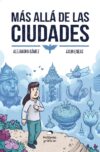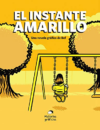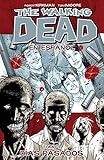
10 Spanish Comic Books to Captivate Learners of All Ages
Open up a comic book and within seconds, you’ll be engrossed in the visual beauty, action-packed drama or post-apocalyptic terror of these gripping stories.
Forget textbooks for an hour (or more).
Instead, jump into a tale that will take you to places where Spanish reading is simple, fun and still educational.
Here are some of our favorite Spanish comic books.
Contents
- 1. “Más allá de las ciudades” by Alejandra Gamez
- 2. “Coda: La bailarina, el hipopótamo y el mur” by H.G. Santarriaga
- 3. “Ardalén” by Miguelanxo Prado
- 4. “El Instante Amarillo” by Bernardo Fernández
- 5. “Arrugas” by Paco Rocas
- 6. “Mortadelo y Filemon” by Francisco Ibanez
- 7. “Dora” by Ignacio Minaverry
- 8. “Iguana Lady: La vida de Graciela Iturbide” by Isabel Quintero
- 9. “Pandora: El Fin de los Dias” (Spanish Language Edition) by Peter J. Ang
- 10. “The Walking Dead” (Spanish Language Edition) by Robert Kirkman
- Why Comic Books Make Amazing Spanish Learning Resources
- Learning Strategies for Spanish Comic Books
- And One More Thing…
Download: This blog post is available as a convenient and portable PDF that you can take anywhere. Click here to get a copy. (Download)
1. “Más allá de las ciudades” by Alejandra Gamez

Lina is a girl living in a giant building in the middle of nowhere. In this place, people are periodically driven by an irresistible instinct to jump off of the building.
But when they do, crows always rescue them and carry them off to somewhere unknown.
When the time comes for Lina to make her jump, she is transported on an adventure through many places and challenges, with the destination still unknown.
This exciting and hopeful fantasy adventure is a tale about the joys and challenges of growing up, and the inevitability of that journey.
2. “Coda: La bailarina, el hipopótamo y el mur” by H.G. Santarriaga

This unusual story takes place in a dystopian future Mexico City. It follows Amok, a young man who works as a mascot and delivery man for a chain that sells giant quesadillas.
Amok is being chased by a gang of drug dealers (who all dress like Elvis Presley) when he meets a dance teacher and falls in love.
This character-driven story sees its hero contemplate his ambitions and values while he gets to know the girl of his dreams (and himself), all against a bizarre yet strangely plausible futuristic backdrop.
3. “Ardalén” by Miguelanxo Prado
With gracefully elegant imagery, Ardalén isn’t only a tale about aging.
It also looks at how our personal memories shape the perceptions we have of our own lives but, in turn, how we’re created by the memories of others too.
A sophisticated graphic novel, this one steps away from the superhero drama to look at the realities of our lives.
4. “El Instante Amarillo” by Bernardo Fernández
María is a 13-year-old girl who’s going through a rough time both in school and at home.
Her parents are fighting, she’s failing algebra and a popular girl is bullying her. María is in love with a boy named Alfredo, but she knows he only sees her as a little girl.
Then, she meets another María, “la mamá del monstro” (the mother of the monster), who lived in the 19th century and changed horror literature forever.
As she begins to identify with this María, she learns to reconcile with her own inner monster so that she can move forward and forge a new path.
5. “Arrugas” by Paco Rocas
Retired bank executive Emilio is suffering from Alzheimer’s and has been moved to an assisted living home.
There, he gets to know his fellow patients and the caretakers while he adjusts to a new routine of medication, naps, gymnastics and trying to avoid being transferred to the dreaded top floor.
Emilio befriends his roommate Miguel, an overconfident ladies’ man, and together they hatch schemes to hide Emilio’s deteriorating condition. They even plan a daring escape.
Paco Rocas researched this graphic novel by interviewing nursing home patients and their families. He covers this often neglected topic with humor and sensitivity.
6. “Mortadelo y Filemon” by Francisco Ibanez
If you’re a fan of Laurel and Hardy or The Three Stooges, then you’ll really enjoy “Mortadelo y Filemon.“
Although this comic book series began in 1958, it has stood the age of time and continues to be a comic book that delights its modern readers.
The slapstick humor revolves around two spies, the angry Filemon and the dimwitted Mortadelo, who embark on disastrous adventures time after time.
If you’re looking for a funny, engaging way to improve your Spanish, then this is the comic book for you.
7. “Dora” by Ignacio Minaverry
This Argentinian comic is about a young female spy who, during the 1960s, becomes a Nazi hunter and travels around Europe and Argentina.
Dora is a great comic that’s nestled in political and global history.
Although a fictional story, it’s based on historical fact, and the attention to detail is fantastic, especially in the specific architectures of each country presented.
8. “Iguana Lady: La vida de Graciela Iturbide” by Isabel Quintero
This graphic novel tells the story of Graciela Iturbide, one of the most important Mexican photographers in recent history.
“Iguana Lady” follows Iturbide in 1970 after the death of her daughter, after which she found herself drawn to photography.
She went on to create some of the most iconic and internationally celebrated images of Mexican people and culture in the later 20th century.
The novel shows her journey and how she was able to meet and learn about many (often overlooked) Mexican people and their cultures. It’s a revealing and interesting story about creation and what it means to be an artist.
9. “Pandora: El Fin de los Dias” (Spanish Language Edition) by Peter J. Ang
With beautiful manga artwork, horror fans will enjoy this apocalyptic graphic novel set in New Jersey.
The story begins when the media exhibition of an ancient artifact unleashes a plague that threatens mankind.
Only some can help save the world against Pandora, the end of days, and Katie is one of those few.
10. “The Walking Dead” (Spanish Language Edition) by Robert Kirkman
Now a major TV show, “The Walking Dead” is about survival not only against the zombies, but also against those fighting to save their own humanity.
Fast-paced with shocking twists and turns, this graphic novel is a social commentary that blends perfectly with good old zombie-apocalyptic horror!
As an added bonus, read the graphic novel and, afterward, binge watch the entire show on Netflix in Spanish.
Why Comic Books Make Amazing Spanish Learning Resources
Visual medium helps with comprehension
The pictures and images associated with these kinds of books act as visual clues which allow you to establish context without needing to understand all of the dialogue.
This makes it easier for Spanish learners to recognize and comprehend the storyline regardless of their Spanish level.
Examples of conversational Spanish
Comic books are direct and to the point which keeps your interest perked up the entire way through.
They also teach you specific conversational Spanish that you can use when speaking Spanish with others.
Easier to finish than novels
Unlike novels and textbooks, comics and graphic novels are much shorter (and lower on text) so you don’t have to worry about translating your way through 300 pages of writing.
You can choose to read one comic strip, a comic book or a whole graphic novel depending on your skill level, mood and amount of available time.
Each of your choices is different sizes, but all of them will help you develop your Spanish skills.
They teach you about culture
Comic books and graphic novels are rich with visual artwork. Every detail has been picked for a specific reason.
Look closely at the environment, the background, the clothes of the characters and the words they choose to use in order to learn more about the culture you’re reading about.
Learning Strategies for Spanish Comic Books
Incorporate some of the tips below to make the most of your time and to further develop your learning skills in a fun and interactive way.
Focus on the visuals and write a description of what you see
Pick one specific image on the page and, using the vocabulary you do know, write a description of the environment, person or furniture in the room.
This can help develop your range of dialogue. You might find that you know many more words than you think.
Write alternative dialogues
Pick a page and write down the dialogue from that scene. Then try to come up with alternative ways of saying that specific dialogue.
This is a great way to improve your current vocabulary and expand it with new word choices. This can also help to increase your knowledge of colloquial Spanish for future conversational use.
Answer the character’s questions
Many comic books and graphic novel characters speak their thoughts, or their thoughts are shown in thought bubbles on the pages.
When you reach a question in the dialogue, pause and write a response to the character’s question before continuing.
Write a review
When you finish a comic, write out your thoughts and opinions about the storyline, including what you’d change and what you wouldn’t change.
Think about how you’d describe and recommend this story if you were talking to a friend in Spanish.
Practice new words
As you’re reading, if you come across new words or ones you aren’t so sure of, save them! Write the words down and build a list to study with.
As you practice new words and progress through your comics, you’ll find yourself looking up fewer and fewer words.
You can build flashcards with words you learn in comics using apps like Anki.
Or, with the FluentU app, you can create flashcard decks for each comic (for example) and see how the words are used in other contexts through Spanish videos.
FluentU takes authentic videos—like music videos, movie trailers, news and inspiring talks—and turns them into personalized language learning lessons.
You can try FluentU for free for 2 weeks. Check out the website or download the iOS app or Android app.
P.S. Click here to take advantage of our current sale! (Expires at the end of this month.)

You can go the traditional route and create flashcards by hand. No matter how you choose to study, as long as you’re practicing, you’ll learn something new.
Sign up for a daily comic strip email
Not all comics are full stories or even weekly portions of a story. Some can be daily cartoons, which is great for always remembering to practice with a little reading.
Sign up for a daily comic cartoon, like “Dilbert en Español,” in order to learn some new Spanish words in seconds.
Comic books and graphic novels will have you learning new words, sentence formats and conversational Spanish phrases in no time.
They’ll also develop and strengthen your reading skills in an enjoyable way.
Remember to take your time, be patient with yourself and the learning will be a breeze!
Download: This blog post is available as a convenient and portable PDF that you can take anywhere. Click here to get a copy. (Download)
And One More Thing…
If you've made it this far that means you probably enjoy learning Spanish with engaging material and will then love FluentU.
Other sites use scripted content. FluentU uses a natural approach that helps you ease into the Spanish language and culture over time. You’ll learn Spanish as it’s actually spoken by real people.
FluentU has a wide variety of videos, as you can see here:

FluentU brings native videos within reach with interactive transcripts. You can tap on any word to look it up instantly. Every definition has examples that have been written to help you understand how the word is used. If you see an interesting word you don’t know, you can add it to a vocab list.

Review a complete interactive transcript under the Dialogue tab, and find words and phrases listed under Vocab.

Learn all the vocabulary in any video with FluentU’s robust learning engine. Swipe left or right to see more examples of the word you’re on.

The best part is that FluentU keeps track of the vocabulary that you’re learning, and gives you extra practice with difficult words. It'll even remind you when it’s time to review what you’ve learned. Every learner has a truly personalized experience, even if they’re learning with the same video.
Start using the FluentU website on your computer or tablet or, better yet, download the FluentU app from the iTunes or Google Play store. Click here to take advantage of our current sale! (Expires at the end of this month.)


